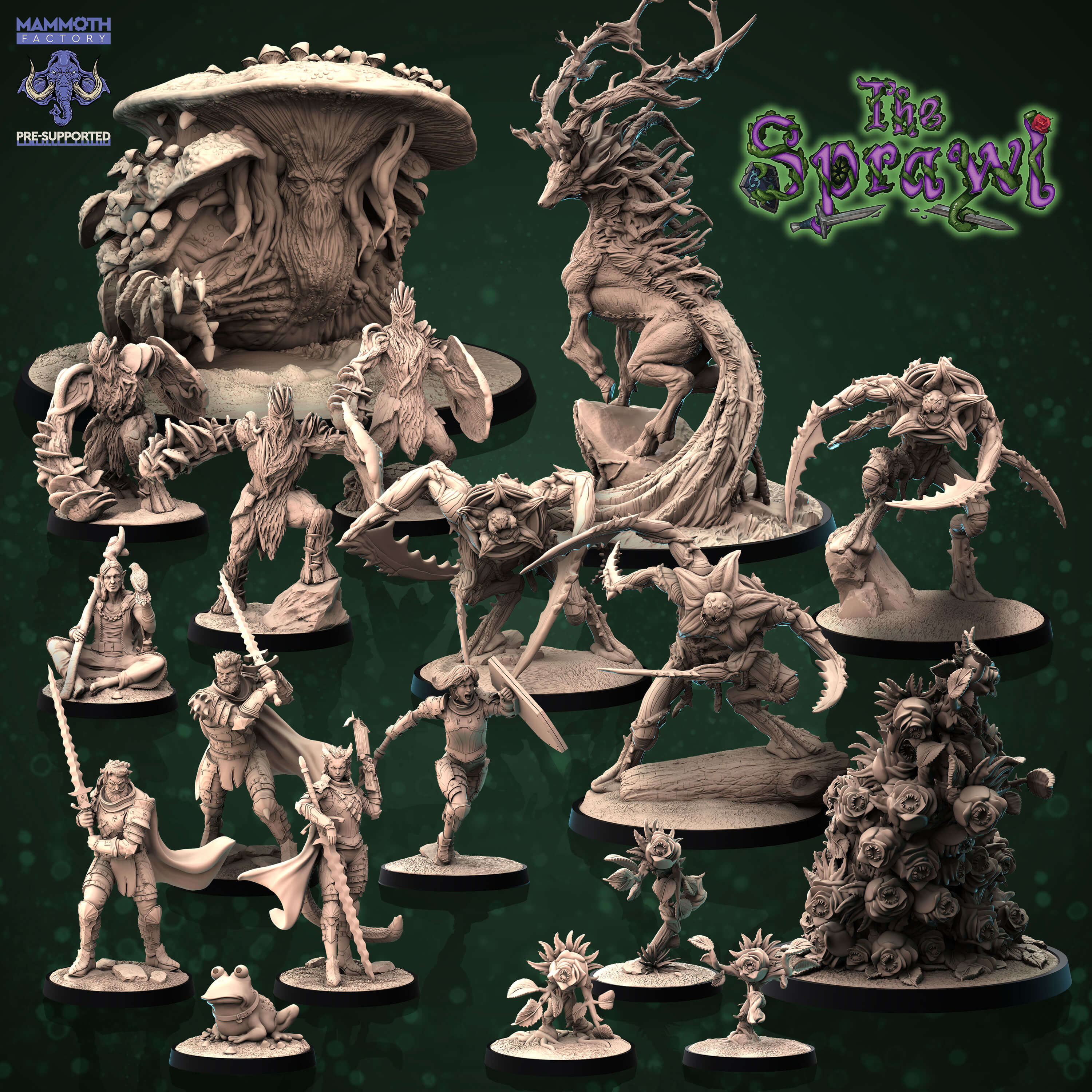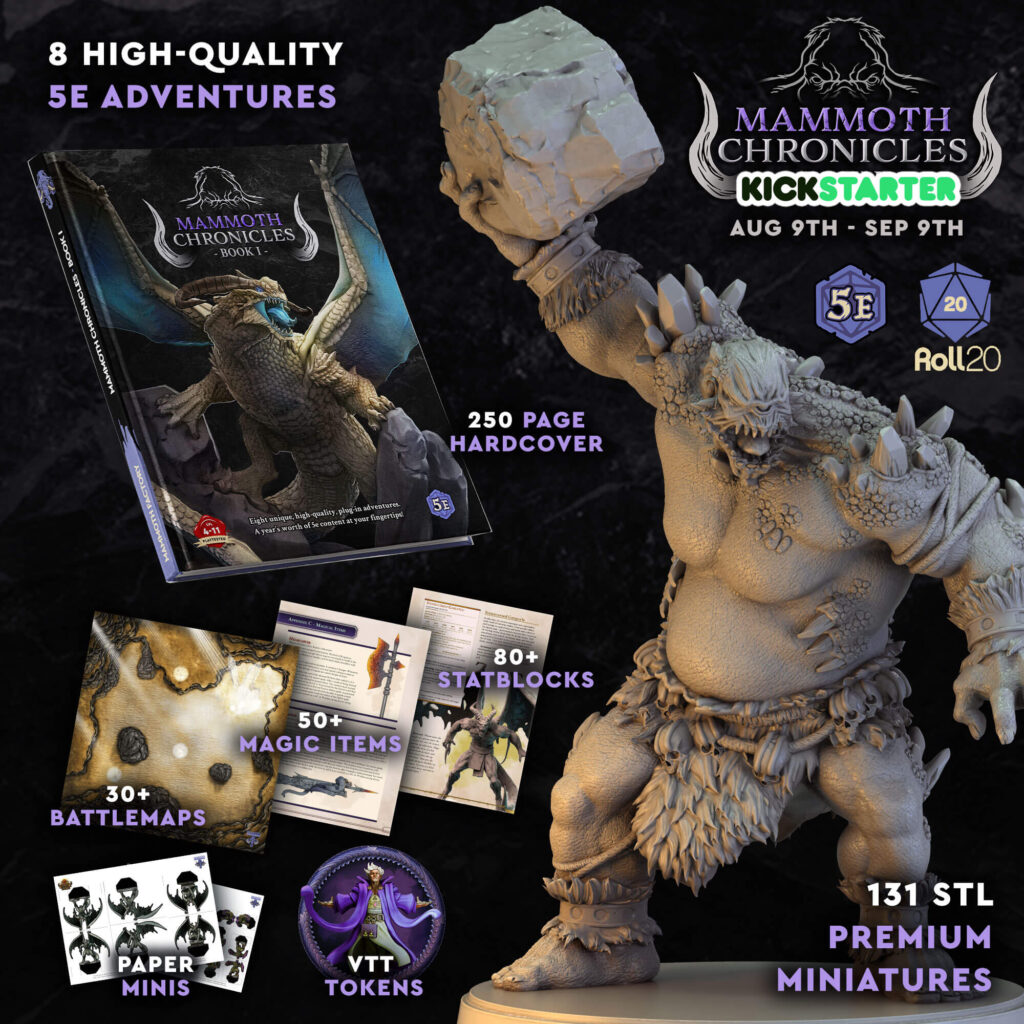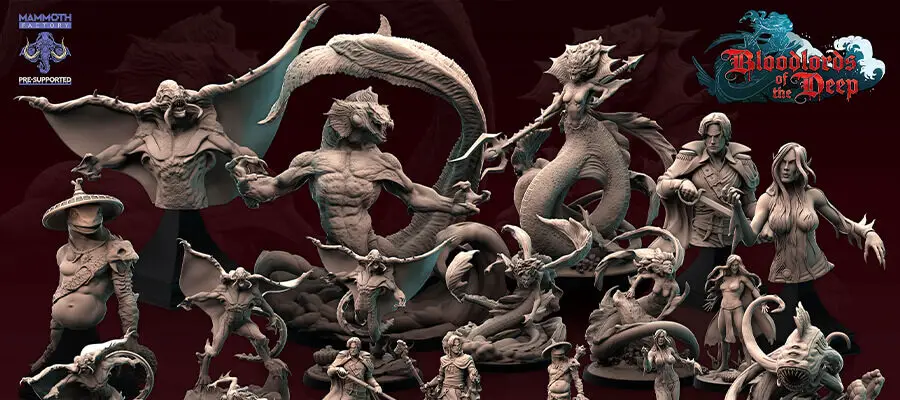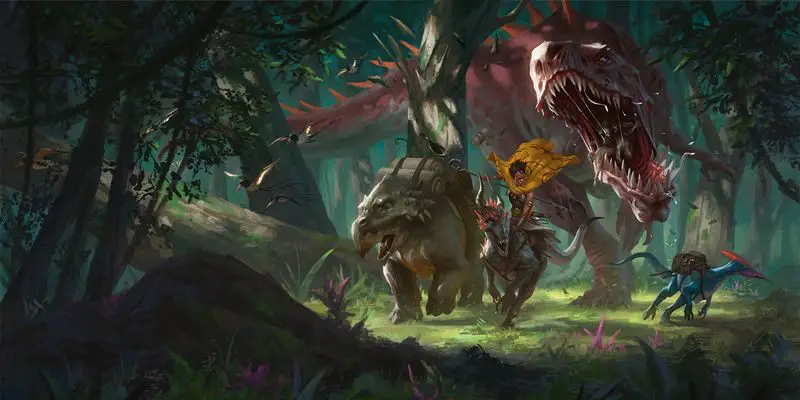This article’s featured image for D&D Minis Custom-Made for Published Adventures is from Mammoth Factory Games, this article’s sponsor. This article contains affiliate links that add gold to our coffers.
Mammoth Factory Games approached me about an upcoming Kickstarter they’re launching (more on that at the end of this article). They asked if Flutes Loot would be suited as a promotional partner. Mammoth Factory Games specializes in 3D-printed minis that complement their original adventures. I’m not a mini collector, but I love the idea of premium minis coupled with adventures made with passion.
MFG’s premise impressed me despite the fact that I’ve never purchased a miniature for D&D in my life. I’ve always used my kids’ toys, poker chips, pieces of candy, and whatever I can find to represent creatures on a battle map. Such was my intrigue that I decided to write about my experiences with miniatures and how MFG’s offering can be helpful to anyone using minis.
First, I’ll talk about why you may enjoy using miniatures in your D&D games and the nuances of doing so.
— Do minis make combat more exciting?
— Are minis worth it in D&D 5e?
— Cautions about using minis.
— What are STLs for 3D printing?
— Tokens for playing D&D online with VTTs
— Minis tailor-made to adventures with Mammoth Factory Games
— Conclusions and resources
Do Minis Make Combat More Exciting?
There are many reasons that a player may feel bored during combat, but one reason may be the format!
Players who enjoy the tactical aspect of D&D may struggle to enjoy the theater of the mind if it’s the exclusive method of visualizing the game. Some players also cope with cognitive needs that can make theater of the mind nearly impossible for them. For example, I’ve spoken with a player who sustained an injury to his brain that obliterated his object permanence. Players like these want (maybe need) visual aids to enjoy the game. The better the visual aids, the better the game can become.
Obviously, thoughtful visual aids are not the only factor that makes a good game. They’re a useful tool for DMs and players to enhance their enjoyment.
D&D rules contain movement speeds, distance requirements, and relative positions that matter to many players. Tactical and visual players will greatly appreciate accurate, scaled models of what is happening.
Are Minis Worth It in D&D?
You can play D&D without miniatures, but they’re fun to have! Some players will benefit from them more than others. If theater of the mind (imagination) is proving insufficient for your campaign, miniatures and maps may become essential.
Aside from the practical benefits, miniatures form a kind of sub-hobby within D&D. Many wargamers who use minis for games like Warhammer 40,000 find that they enjoy using minis in D&D, too. Finding the right minis, painting them, and tailoring adventures to use them is enjoyable for many DMs.
There are many channels on YouTube that especially demonstrate how to create terrain and paint miniatures for various games. There is clearly a large audience of people who enjoy miniatures as a hobby. I have friends who have played D&D before and are painting minis because it’s fun. They’re not playing D&D in recent years, but they still paint miniatures.
Mammoth Factory Games has resources on MyMiniFactory for premium STL minis (jaw-dropping quality)! You can find Reference this article by Level 1 Geek for a worthy overview of reliable pre-made, cheap mini providers. Read this article by Arcane Eye to learn about the finer points of mini considerations.
A Word of Caution about D&D Minis and Terrains
Remember, a prepared DM can keep the game moving so players don’t lose interest and the momentum keeps up. If you’re using miniatures, I recommend keeping them nearby and placing the ones that you expect to use within reach. Theater of the mind will often be sufficient for quick skirmishes without needing to draw a quick battle map or place a bunch of miniatures.
For example, I once had a DM take several minutes to draw out a battle scene and place minis only to have us as players choose to flee since the encounter didn’t help us achieve our goals within a delicate timeline. This wasted several minutes of game time to set up and remove a scenario that didn’t matter or didn’t proceed as the DM assumed.
Prepare your miniatures and terrains in another room. Keep them set up anywhere you can quickly bring them in for the players to see. This will save you precious in-game time while still allowing you to craft beautiful scenarios.
What Are STL D&D Minis?
STL is a file type for 3D printing. If a miniature or figurine is classified as an STL product, it’s a file that you can use to 3D print the miniature itself. You must print and/or paint them, and they don’t ship to you.
Printing miniatures can take several hours per miniature. Material costs per miniature (according to a friend of mine) might run up to $5 for high-quality prints.
You must paint miniatures that you print if you want them colored. Store-bought minis also typically lack color. They cost much more when they come pre-painted/colored.
What Does STL Mean?
According to 3D Printing Buff: “STL is a file format commonly used for 3D printing and computer-aided design (CAD). The name STL is an acronym that stands for stereolithography — a popular 3D printing technology. You might also hear it referred to as Standard Triangle Language or Standard Tessellation Language.”
3D printing is an art. Its learning curve includes disappointing first-draft projects to learn the craft’s finer points. You will learn about nozzle size, material, and other considerations.
Here is what 3D printing can achieve:

Tokens for Playing D&D Online with Virtual Tabletops (VTTs)
Digital games of D&D obviously will have no use for physical miniatures unless the DM places a camera on a battle map for their players. Most games played online use a Virtual Tabletop (VTT) like Roll20 or Foundry. In those cases, players need tokens instead of miniatures.
Tokens are digital images that can be placed as indicators of creatures in a VTT. As I’ve done with miniatures, I grab whatever I have available. VTTs often have a database of free or paid token images that can be searched. They’re not perfect, but I value those tools when I need a quick token.
Miniatures and tokens are useful in social, non-combat scenarios, too. DMs can bring gravitas to a situation by bothering to map it out and placing minis to represent characters.
Players may enjoy picking their own artwork for their tokens. If you’re not broadcasting your game, you can freely find artwork to represent your characters and paint vivid pictures for fellow players.
Mammoth Factory Games supports DriveThru RPG and Roll20.
D&D 5e Minis that Are Tailor-Made for Published Adventures
Mammoth Factory Games writes adventures that are guaranteed to showcase their premium miniatures. This is a fantastic selling point to me if I want to play in person, but they also cater to VTTs for online play. They launched a Kickstarter called Mammoth Chronicles on August 9th, 2022 (the day this article published):

- 8 high-quality adventures for D&D 5e in a 250-page hardcover book.
- They have playtested their adventures thoroughly themselves! This is evidenced to me in that their PDF files have version indicators that imply they’ve gone through many revisions to improve them.
- Because of my love for Curse of Strahd, I’m drawn to MFG’s adventure “Bloodlords of the Deep” for nautical vampire scenarios. “The Sprawl” is a mushroomy forest adventure that my wife Opal would surely appreciate.
- 131 premium STL miniatures that are tailored to the adventures.
- All miniatures are pre-supported & test-printed STL & LYS files. You can view each STL miniature on MFG’s FB page.
- Remember, STL is a 3D-printing file type, so they won’t be printed for you, but you can print them as many times as you want to create an army!
- Printing takes time and materials to do, so make sure you temper your expectations with the time and money you’ll need to invest to print STL files into miniatures. If you want to paint them after printing to give them color, they require more time.
- A friend of mine who does 3D printing said the main cost of these premium STL minis will be the cost of “time due to slowing it for the nozzle size and detail.”
- 30+ battle maps.
- 50+ magic items.
- 80+ statblocks.
- I often see books skip out on custom statblocks, but Mammoth Factory Games exceeded my expectation here. Having said that, some of the statblocks are very simplistic, but I kind of like their minimalism.
- Paper minis.
- Easy-to-print alternative for casual visuals. They recommend taping a coin or similar object to the bottom of the paper minis.
- VTT tokens for online play.
- Free CR20 Legendary Mammoth STL & statblock on the KS page.
- This monster, Ammaroth the Unstoppable, is also available by subscribing to their newsletter.
- Very cool monster, though I think its CR is too high.
- ‘1$ Dragon’ Tier: A radiant dragon STL ($15 MSRP) with a PDF / Roll20 one-shot.
I spoke to the company on the phone and could tell that they had actually playtested their adventures and poured love and time into them. Their passion and expertise are what prompted me to write about miniatures and promote their Kickstarter campaign. Check out their stretch goals and other goodies in the campaign because there is plenty to look forward to. You can expect fast delivery on this KS because 90% of the content is already done.
Consider supporting them while getting some insanely cool assets and products for your effort! If you read this article after the Mammoth Chronicles Kickstarter concludes, you can find Mammoth Factory Games to see what they have for you. They also have a Patreon and a Discord server. You can also purchase their minis printed already here, but they’re more expensive if you want them printed.
Conclusion
Miniatures are a fantastic sub-culture within gaming and TTRPGs. They bring joy to many enthusiasts, and they’re artistic tools for DMs to utilize. Make sure you are prepared and mindful when using them, so they don’t work against you accidentally. STL miniatures are for 3D printing.
How do you use minis, terrains, and tokens in your games? Cast Message in the comments below to tell me all about your method or ask me about Mammoth Factory Games.
You may also enjoy this DM round table video on our YouTube channel discussing the value and culture of art in D&D games and publications:




